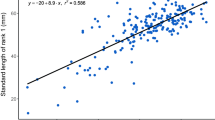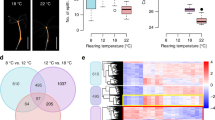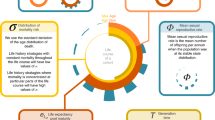Abstract
Investigation of vertebrate regulatory biology is restricted by the modest response amplitudes in mammalian model species that derive from a lifestyle of frequent small meals. By contrast, ambush-hunting snakes eat huge meals after long intervals. In juvenile pythons during feeding, there are large and rapid increases in metabolism and secretion, in the activation of enzymes and transporter proteins, and in tissue growth. These responses enable an economic hypothesis concerning the evolution of regulation to be tested. Combined with other experimental advantages, these features recommend juvenile pythons as the equivalent of a squid axon in vertebrate regulatory biology.
This is a preview of subscription content, access via your institution
Access options
Subscribe to this journal
Receive 51 print issues and online access
$199.00 per year
only $3.90 per issue
Buy this article
- Purchase on Springer Link
- Instant access to full article PDF
Prices may be subject to local taxes which are calculated during checkout





Similar content being viewed by others
References
Secor, S. M. & Nagy, K. A. Bioenergetic correlates of foraging mode for the snakes Crotalus cerastes and Masticophis flagellum. Ecology 75, 1600–1614 (1994).
Greene, H. W. Snakes: The Evolution of Mystery in Nature (California Press, Berkeley, (1997)).
Pope, C. H. The Giant Snakes (Knopf, New York, (1961)).
Secor, S. M. & Diamond, J. Determinants of post-feeding metabolic response in Burmese pyhthons (Python molurus). Physiol. Zool. 70, 202–212 (1997).
Diamond, P., Brondel, L. & LeBlanc, J. Palatability and postprandial thermogenesis in dogs. Am. J. Physiol. 248, E75–E79 (1985).
Kleiber, M. The Fire of Life: An Introduction to Animal Energetics (Wiley, New York, (1961)).
Secor, S. M. & Diamond, J. Adaptive response to feeding in Burmese pythons, pay before pumping. J. Exp. Biol. 198, 1313–1325 (1995).
Secor, S. M. & Diamond, J. Effects of meal size on postprandial responses in juvenile Burmese pythons (Python molurus). Am. J. Physiol. 272, R902–R912 (1997).
Janes, D. N. & Chappell, M. A. The effect of ration size and body size on specific dynamic action in Adélie penguin chicks, Pygoscelis adeliae. Physiol. Zool. 68, 1029–1044 (1995).
Field, J., Belding, H. S. & Martin, A. W. An analysis of the relation between basal metabolism and summated tissue respiration in the rat. J. Cell. Comp. Physiol. 14, 143–157 (1939).
Felsenstein, J. Phylogenies and the comparative method. Am. Nat. 125, 1–15 (1985).
Garland, T., Harvey, P. H. & Ives, A. R. Procedures for the analysis of comaprative data using phyologenetically independent contrasts. Syst. Biol. 41, 18–32 (1992).
Secor, S. M. Ecological aspects of foraging mode for the snakes Crotalus cerastes and Masticophis flagellum. Herp. Monogr. 9, 169–186 (1995).
Secor, S. M., Stein, E. D. & Diamond, J. Rapid up-regulation of snake intestine in response to feeding: a new model of intestinal adaptation. Am. J. Physiol. 266, G695–G705 (1994).
Conlon, J. M., Secor, S. M., Adrian, T. E., Mynarcik, D. C. & Whittaker, J. Purification and characterization of islet hormones (insulin, glucagon, pancreating polypeptide and somatostatin) from the Burmese python, Python molurus. Regul. Pept. 71, 191–198 (1997).
Conlon, J. M., Adrian, T. E. & Secor, S. M. Tachykinins (substance P, neurokinin A and neuropeptide y), and neurotensin from the intestine of the Burmese python, Python molurus. Peptides 18, 1505–1510 (1997).
Acknowledgements
This work was supported by grants from the NIH. We gratefully acknowledge our many collaborators named in our previous publications.
Author information
Authors and Affiliations
Corresponding author
Rights and permissions
About this article
Cite this article
Secor, S., Diamond, J. A vertebrate model of extreme physiological regulation. Nature 395, 659–662 (1998). https://doi.org/10.1038/27131
Issue Date:
DOI: https://doi.org/10.1038/27131
This article is cited by
-
Utility of the burmese Python as a model for studying plasticity of extreme physiological systems
Journal of Muscle Research and Cell Motility (2023)
-
Identification of an integrated stress and growth response signaling switch that directs vertebrate intestinal regeneration
BMC Genomics (2022)
-
Diurnal changes in the murine small intestine are disrupted by obesogenic Western Diet feeding and microbial dysbiosis
Scientific Reports (2021)
-
The effect of fasting on nutritional status, organs size and isotopic composition in a Neotropical fish species (Jenynsia multidentata)
Hydrobiologia (2019)
-
Migratory coupling between predators and prey
Nature Ecology & Evolution (2018)
Comments
By submitting a comment you agree to abide by our Terms and Community Guidelines. If you find something abusive or that does not comply with our terms or guidelines please flag it as inappropriate.



